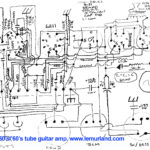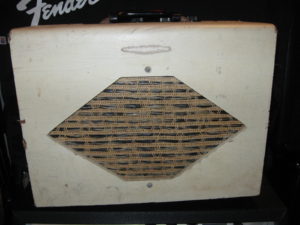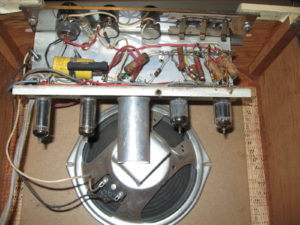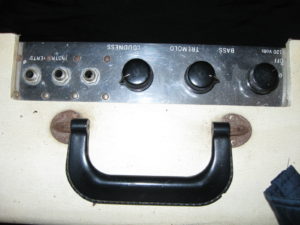I’ve been able to learn very little about this recent acquisition. I’d be glad to hear from anyone who may have some information regarding this vintage tube amp.
I’ve drawn up a schematic of this vintage 50eh5 tube amp here.
The value of some components, such as the early ceramic capacitors remain inconclusive.
Although some features bear a remote resemblance to several known amplifiers, I consider this vintage 50’s amp to be of a yet unknown maker. The amp is powered by a duo of vintage General 50eh5 tubes. A prized Hitachi 12AX7 and a GE 6211 serve in the preamp and tremolo stages. The circuitry appears to be completely stock and retains a hot chassis design. Unfused and ungrounded. For safety, future modifications will include the addition of a grounded isolation transformer. The amp also currently utilizes only a single blocking diode for rectification. Component choices of interest include obsolete dual capacitors and ancient color-coded ceramic capacitors sitting alongside the typical early wax capacitors and carbon comp resistors.
The 6 1/2″ alnico Fisher speaker bears a date code of 014 which translates to week 14 of either 1950 or 1960. Although difficult to read due to their positioning, the potentiometers may bear a date code of 2, most likely meaning 1952 or 1962. To nail the date down on this amp, at this time I’m relying on the date stamped on the 35 mf octal cap– 8-51. Although it’s uncertain… from the information above, I’d like to say this amp was made in 1952.
The cabinet is made of plywood and is covered in both white and black “book-binding” cloth. Note the layout of the controls below. A switched potentiometer serves to regulate both bass and power. The volume control is labelled “Loudness”.
It’s quite possible this amp was once powered by a pair of 50C5 tubes. This would be consistent with my guess as to the amplifier’s date since, according to the Electron Tube Registration List, 50EH5 tubes, a replacement for the 50c5’s, came into production a bit later; in 1958 (source: radiomuseum.org). Stadium was one such company that manufactured a series of similar amps.






